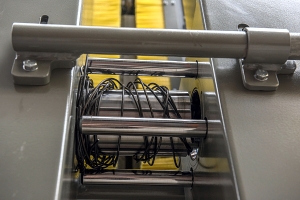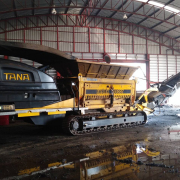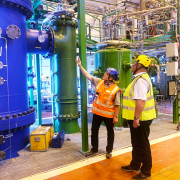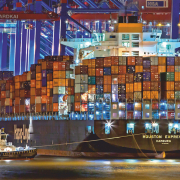CW Dewiring: Improves Working Safety and Lowers Labor Costs
The beginning of Cross Wrap dates back to 1992 when the founder of the Finland-based company had the vision for an innovative way of wrapping square bales and other rectangular end products. Two years later the first Cross Wrap machine was built.
Nowadays, the company has installed machines in over 50 countries. Nevertheless, in all these years, the mission has always been the same: Help companies to operate smarter when it comes to bale or package handling, wrapping, opening, and also dewiring. Therefore, GLOBAL RECYCLING Magazine wanted to know more about Cross Wrap’s dewiring machine, which cuts the bale wires, separates them from the material, and coils the wires for further processing.
What are the main features and functions of the CW Dewiring machine?
The CW Dewiring machine’s main features are its all automatic operation and the fact that it cuts, separates and coils the metal bale wires that are used to tie recycled plastic or paper bales. The Dewiring machine is a spin-off from the Cross Wrap bale opener machine that has been developed for the waste to energy operators, facilities and cement kilns.
The Dewiring machine’s functions are gentle bale feeding with a belt conveyor, automatic bale wire gripping, bale wire cutting, wire removing and bale wire coiling. After the wires are removed from the material, the bale content is moved forward to the process from the machine. At the moment, there exists one version of the Dewiring machine for narrow box baled bales, and there is also another version for wide box baled bales.
All of the Cross Wrap machinery uses the latest Siemens automation and state of the art components in sensing as well as in running gear. The user interfaces are engineered to be user-friendly, and there are options for remote controlling, online updating and troubleshooting. One feature of the CW Dewiring is also its modular structure, which helps in layout planning and fitting it to any existing or new processing line.
In which way does the CW Dewiring machine reduce expenses?
The Cross Wrap Dewiring machine lowers labor costs by eliminating the need for manual wire cutting and bale opening. The machine only needs its feeding conveyor to be fed with bales and the opening and cutting is timed by end process infeed speed. By cutting and removing the wires automatically, the processor’s benefits are high in operations that run in multiple shifts. For this the Dewiring machines payback time is short and upgrading to all automatic bale dewiring is lucrative in an economical way.
For which kind of materials is the machine appropriate?
The Cross Wrap Dewiring machine is suitable for various baled materials. For now, applications have been delivered for different materials. Machines are delivered for plastic recycling to dewire PET and HDPE-bales as well as mixed plastic bales. Another material has been recycled paper. Moreover, there have been deliveries for dewiring waste fuel bales in cases where an automatically dewiring of tied RDF- and SRF-bales has been needed. As Cross Wrap is an engineering and manufacturing company focussing on bale handling, we also thrive on creating solutions for unfamiliar materials. Because of this, we want to encourage our present and future customers to challenge us with their needs and ideas for other materials and applications. If the material can be baled it most certainly can be wrapped, opened or dewired with a Cross Wrap machine.
In which ways does the CW Dewiring machine increase treatment safety?
The Cross Wrap Dewiring machine helps to improve working safety by eliminating the need for manual bale dewiring, bale opening, and wire coiling. All of the machines’ automatic operation minimize the risks for injuries caused by manual high-tension wire cutting. The automatic operation is also safer when the material is not clean. Hazardous and unclean materials always pose a health risk for workers when the material is handled manually. Furthermore, the automatic wire coiling operation is beneficial for working safety because the coiled wires are easy to handle. In cases where the bale wires are handled manually, they can tangle and tore up workers posing a high risk of injury. By using CW Dewiring, the wires are coiled automatically to a form that takes very little space and is safe to handle.
As the CW Dewiring operation is all automatic and all machine movements are isolated behind machine frame structure and electronically operated safety fences there is no need for workers to be in harm’s way. The machine controls are done from a safe position. Moreover, the usage of the latest user interface and automation technology also helps in creating a safe working environment.
(GR 32019, Page 40, Photo: Cross Wrap Oy Ltd)










